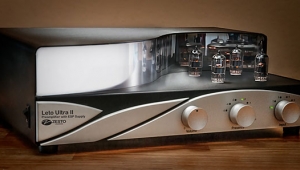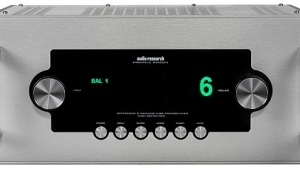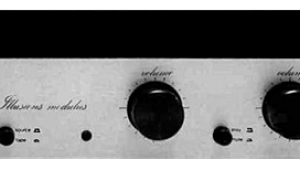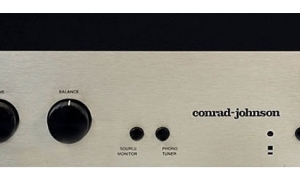| Columns Retired Columns & Blogs |
Musical Fidelity Tri-Vista kWP preamplifier & Tri-Vista kW Monobloc power amplifier Tri-Vista kWP Measurements
Sidebar 5: Tri-Vista kWP Measurements
The kWP is unusual in having a full-featured phono stage. The moving-magnet stage's input impedance was to specification at 68k ohms or 47k ohms, depending on the positions of the rear-panel DIP switches. The moving-coil stage input loading was 125 ohms at 1kHz when set to "100 ohms," 12 ohms when set to "10." Measured at the tape output jacks, the phono-stage gain was 40dB (MM) and 57dB (MC), the latter a little on the low side for the lowest-output MC cartridges.
The kWP offered superb RIAA de-emphasis accuracy (fig.8), though there was a slight (0.25dB) channel imbalance. Set to "RIAA," the phono-stage response extended down to below 10Hz; set to "IEC," it showed the specified 3dB rolloff at 20Hz. Channel separation (not shown) was a superb 110dB at 10kHz, though this was reduced at lower frequencies by the effect of the RIAA equalization. At greater than 60dB at 100Hz, however, it is still way better than any phono cartridge.

Fig.8 Musical Fidelity kWP phono stage, RIAA error with RIAA de-emphasis (top) and IEC de-emphasis (bottom). (0.5dB/vertical div., right channel dashed.)
Whether measured via its MM or its MC input jacks, the kWP had the highest phono-stage overload margin in the midrange and bass I have ever encountered. Assessed at the tape out jacks at 1kHz, for example, the MM input overloaded (1% THD) at 439mV, which is 38.9dB above the reference 5mV input, and equivalent to an extraordinary 43V output! Similar performance was noted from the MM input at frequencies down to 20Hz, while the MC input offered even better overload margins, at 46dB at 20Hz and 1kHz. This astonishing overload performance degraded with increasing frequency, reaching a still excellent 25.9dB (MC) and 19.2dB (MM) at 20kHz. Despite these extraordinary overload margins, the phono stage's S/N ratios were excellent, at 70dB (MM, ref. 5mV input at 1kHz) and 61.5dB (MC, ref. 500;uV input at 1kHz). Both of these figures are unweighted, wideband, taken with the inputs shorted; switching in an A-weighting filter improved them to 83.8dB and 74dB, respectively.
Perhaps not unexpectedly, the kWP phono stage's high dynamic range was accompanied by excellent linearity. Driving the MM input with a 1kHz signal at 1mV gave just 0.0018% THD (sum of harmonics). Though the second harmonic was the highest in level (fig.9), at -96dB it is not going to bother anyone. However, phono-stage intermodulation was good rather than excellent, with an equal mix of 19 and 20kHz tones at 10mV giving rise to 0.1% of the 1kHz difference product (not shown).

Fig.9 Musical Fidelity kWP phono stage, spectrum of 1kHz sinewave, DC-10kHz, at 1V into 8k ohms (linear frequency scale).
The Tri-Vista kWP's line stage had a very high input impedance, at well above 300k ohms. (It is difficult to get an accurate measurement with such high values.) It didn't invert absolute polarity, and its maximum gain was very slightly higher than specified, at 12.9dB rather than 12.5dB. Correlating with this, setting the volume control to an indicated "0dB" resulted in a residual gain of 0.5dB.
The kWP's output impedance was more like that of a power amplifier than a preamplifier. At 1kHz it was an extraordinarily low 0.2 ohm, rising to 0.7 ohm at 20Hz and 0.14 ohm at 20kHz. However, as these figures include the series resistance of a 6' interconnect, the true source impedance is likely to be even lower! The tape out jacks don't appear to be actively buffered.
As the kWP doesn't have a balance control, I was somewhat bothered to find a slight channel imbalance that varied with the volume-control setting. This can be seen in my plot of the line stage's frequency response (fig.10). With the volume control at its maximum position (top pair of traces), the response was flat up to 20kHz, 3dB down at 160kHz, with the right channel 0.05dB lower in level than the left. Repeating the measurement at the same output voltage but with the volume control set to "0dB" reduced the -3dB point to 85kHz but, more important, there was now a 0.45dB imbalance between the channels. Reducing the volume to an indicated "-10dB" increased the imbalance to 0.55dB, but now the right channel was louder than the left (not shown), which suggests that the kWP's volume control offers its best channel gain matching in the region where it is most likely to be used: at around 6dB of attenuation.

Fig.10 Musical Fidelity kWP line stage, frequency response at 1V into 100k ohms with volume control at max (top above 10kHz) and at unity gain (bottom). (0.5dB/vertical div., right channel dashed.)
The kWP's noise level was very good, with an unweighted, wideband S/N ratio of 70.2dB ref. 1V output. This improved to 90dB when A-weighted. Any crosstalk was buried within this noise below 10kHz or so, with perhaps a very slight degree of capacitive coupling reducing the separation to a still superb 105dB at 50kHz (not shown).
The stated design goal of Musical Fidelity's kW products was to achieve very high dynamic range. The kWP achieved this goal in spades: I wasn't able to drive its line stage into clipping with my Audio Precision System One! Fig.11 shows the preamplifier's THD+noise percentage plotted against the output voltage into 100k, 10k, and 1k ohm. Into 100k ohms, the maximum output voltage I could obtain was 55V, with a distortion figure of just 0.001%! Only into 1k ohm did the trace in this graph take on the usual "clipping" shape, but even then, the kWP delivered 57V at 0.65% distortion! I didn't measure the clipping voltage into lower impedances because the precision resistors in my resistance switch box are rated at only 1W power handling; I didn't want the kWP to melt them. But it's safe to predict that the kWP will not be driven into clipping into any real-world impedance it is likely to encounter.
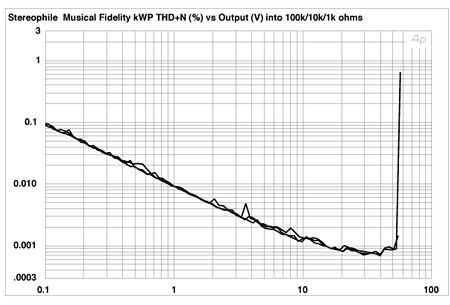
Fig.11 Musical Fidelity kWP line stage, distortion (%) vs 1kHz output voltage into (from bottom to top): 100k ohms, 10k ohms, 1k ohm.
As might be expected, the kWP's distortion is vanishingly low in level at normal output levels. Fig.12 shows a spectral analysis of the preamp's output while it drove a 1kHz tone at 1V into 8k ohms. The THD (sum of the harmonics) was just 0.0007%, with the second harmonic the highest in level at -104dB (0.0006%), and only the third and fourth just discernible above the background noise. Only in the HF intermodulation test did the kWP miss a beat, and then only very slightly. With the preamplifier driving an equal mix of 19 and 20kHz tones at 1V into 8k ohms, the 1kHz difference product reached -80dB (0.01%), with some higher-order products visible (fig.13). They are all low in level, however, and would not affect the preamp's sound quality.

Fig.12 Musical Fidelity kWP line stage, spectrum of 1kHz sinewave, DC-10kHz, at 1V into 8k ohms (linear frequency scale).

Fig.13 Musical Fidelity kWP, line stage HF intermodulation spectrum, DC-24kHz, 19+20kHz at 1V into 8k ohms (linear frequency scale).
Both the Tri-Vista kW and the kWP offer extraordinary dynamic range without their performance in any other area being compromised.—John Atkinson
- Log in or register to post comments







